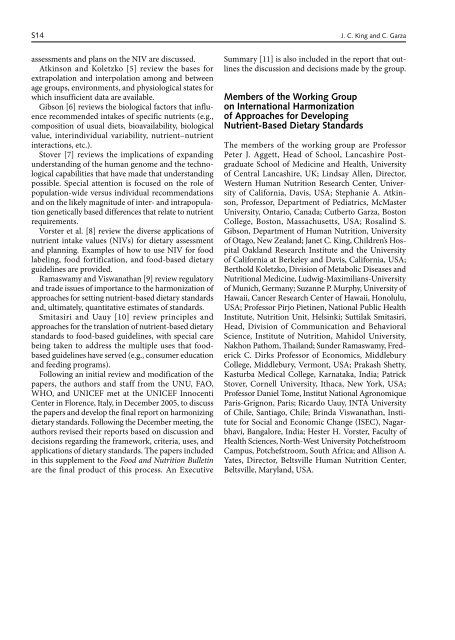Implementing food-based dietary guidelines for - United Nations ...
Implementing food-based dietary guidelines for - United Nations ...
Implementing food-based dietary guidelines for - United Nations ...
You also want an ePaper? Increase the reach of your titles
YUMPU automatically turns print PDFs into web optimized ePapers that Google loves.
S14<br />
assessments and plans on the NIV are discussed.<br />
Atkinson and Koletzko [5] review the bases <strong>for</strong><br />
extrapolation and interpolation among and between<br />
age groups, environments, and physiological states <strong>for</strong><br />
which insufficient data are available.<br />
Gibson [6] reviews the biological factors that influence<br />
recommended intakes of specific nutrients (e.g.,<br />
composition of usual diets, bioavailability, biological<br />
value, interindividual variability, nutrient–nutrient<br />
interactions, etc.).<br />
Stover [7] reviews the implications of expanding<br />
understanding of the human genome and the technological<br />
capabilities that have made that understanding<br />
possible. Special attention is focused on the role of<br />
population-wide versus individual recommendations<br />
and on the likely magnitude of inter- and intrapopulation<br />
genetically <strong>based</strong> differences that relate to nutrient<br />
requirements.<br />
Vorster et al. [8] review the diverse applications of<br />
nutrient intake values (NIVs) <strong>for</strong> <strong>dietary</strong> assessment<br />
and planning. Examples of how to use NIV <strong>for</strong> <strong>food</strong><br />
labeling, <strong>food</strong> <strong>for</strong>tification, and <strong>food</strong>-<strong>based</strong> <strong>dietary</strong><br />
<strong>guidelines</strong> are provided.<br />
Ramaswamy and Viswanathan [9] review regulatory<br />
and trade issues of importance to the harmonization of<br />
approaches <strong>for</strong> setting nutrient-<strong>based</strong> <strong>dietary</strong> standards<br />
and, ultimately, quantitative estimates of standards.<br />
Smitasiri and Uauy [10] review principles and<br />
approaches <strong>for</strong> the translation of nutrient-<strong>based</strong> <strong>dietary</strong><br />
standards to <strong>food</strong>-<strong>based</strong> <strong>guidelines</strong>, with special care<br />
being taken to address the multiple uses that <strong>food</strong><strong>based</strong><br />
<strong>guidelines</strong> have served (e.g., consumer education<br />
and feeding programs).<br />
Following an initial review and modification of the<br />
papers, the authors and staff from the UNU, FAO,<br />
WHO, and UNICEF met at the UNICEF Innocenti<br />
Center in Florence, Italy, in December 2005, to discuss<br />
the papers and develop the final report on harmonizing<br />
<strong>dietary</strong> standards. Following the December meeting, the<br />
authors revised their reports <strong>based</strong> on discussion and<br />
decisions regarding the framework, criteria, uses, and<br />
applications of <strong>dietary</strong> standards. The papers included<br />
in this supplement to the Food and Nutrition Bulletin<br />
are the final product of this process. An Executive<br />
Summary [11] is also included in the report that outlines<br />
the discussion and decisions made by the group.<br />
Members of the Working Group<br />
on International Harmonization<br />
of Approaches <strong>for</strong> Developing<br />
Nutrient-Based Dietary Standards<br />
J. C. King and C. Garza<br />
The members of the working group are Professor<br />
Peter J. Aggett, Head of School, Lancashire Postgraduate<br />
School of Medicine and Health, University<br />
of Central Lancashire, UK; Lindsay Allen, Director,<br />
Western Human Nutrition Research Center, University<br />
of Cali<strong>for</strong>nia, Davis, USA; Stephanie A. Atkinson,<br />
Professor, Department of Pediatrics, McMaster<br />
University, Ontario, Canada; Cutberto Garza, Boston<br />
College, Boston, Massachusetts, USA; Rosalind S.<br />
Gibson, Department of Human Nutrition, University<br />
of Otago, New Zealand; Janet C. King, Children’s Hospital<br />
Oakland Research Institute and the University<br />
of Cali<strong>for</strong>nia at Berkeley and Davis, Cali<strong>for</strong>nia, USA;<br />
Berthold Koletzko, Division of Metabolic Diseases and<br />
Nutritional Medicine, Ludwig-Maximilians-University<br />
of Munich, Germany; Suzanne P. Murphy, University of<br />
Hawaii, Cancer Research Center of Hawaii, Honolulu,<br />
USA; Professor Pirjo Pietinen, National Public Health<br />
Institute, Nutrition Unit, Helsinki; Suttilak Smitasiri,<br />
Head, Division of Communication and Behavioral<br />
Science, Institute of Nutrition, Mahidol University,<br />
Nakhon Pathom, Thailand; Sunder Ramaswamy, Frederick<br />
C. Dirks Professor of Economics, Middlebury<br />
College, Middlebury, Vermont, USA; Prakash Shetty,<br />
Kasturba Medical College, Karnataka, India; Patrick<br />
Stover, Cornell University, Ithaca, New York, USA;<br />
Professor Daniel Tome, Institut National Agronomique<br />
Paris-Grignon, Paris; Ricardo Uauy, INTA University<br />
of Chile, Santiago, Chile; Brinda Viswanathan, Institute<br />
<strong>for</strong> Social and Economic Change (ISEC), Nagarbhavi,<br />
Bangalore, India; Hester H. Vorster, Faculty of<br />
Health Sciences, North-West University Potchefstroom<br />
Campus, Potchefstroom, South Africa; and Allison A.<br />
Yates, Director, Beltsville Human Nutrition Center,<br />
Beltsville, Maryland, USA.




